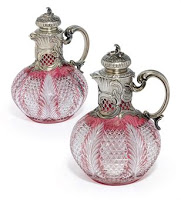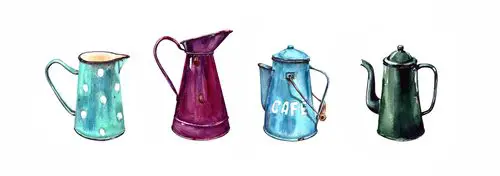Having l ooked into the future of wine bottles last week I thought it would be interesting to look at the past. Claret Jugs were a phenomenon of the Victorian and Edwardian age and were produced from about 1830 to 1920. Nowadays they are very collectible and can be found in a variety of beautiful styles and forms.
ooked into the future of wine bottles last week I thought it would be interesting to look at the past. Claret Jugs were a phenomenon of the Victorian and Edwardian age and were produced from about 1830 to 1920. Nowadays they are very collectible and can be found in a variety of beautiful styles and forms.
The most famous Claret Jug is the golfing trophy awarded to the winner of The Open Championship. It’s officially known as the Championship Cup, but it is much more commonly called the “Claret Jug” because, well, it’s a Claret Jug!
It was hallmarked in 1873 and Tom Kidd was the first to be awarded the Claret Jug that same year.  That original Claret Jug from 1873 has permanently resided at the Royal and Ancient Golf Club of St Andrews since 1928.
That original Claret Jug from 1873 has permanently resided at the Royal and Ancient Golf Club of St Andrews since 1928.
The trophy that is presented to the British Open winner each year is a copy of the original, which the winner gets to keep for a year before returning it to Saint Andrews to be passed on to the next champion.
The silver mounted Claret Jug can trace its origins to the Elizabethan era. Throughout the Middle Ages, pottery vessels had been the basic utensil for serving wine, with the exception of silver which was sparingly used by the very wealthiest families.
The Spanish conquest of Latin America and the exploits of British buccaneers, like Sir Francis D rake, eventually made the metal more readily available in England and throughout Europe.
rake, eventually made the metal more readily available in England and throughout Europe.
During this same period, there was a strong tradition of mounting precious objects with silver in Continental Europe. Fine porcelains brought back from the Dutch East Indies were regularly enhanced with silver rims or handles, as were cups, made from precious materials such as nautilus shells, rhinoceros horn and rock crystal.
For most of the 18th century, wines were either served out of solid silver vessels, or from glass decanters and bottles. Most households purchased wines in casks which were stored in the cellar, from which the head butler would decant into the chosen serving vessel prior to the meal.
Decanting the wine meant that the sediment was left behind in the bottle. This process was known as ‘canting’, and as early as 1710 the vessel that received the wine was being referred to in advertisements as a ‘decanter’. It was not until the early 19th century when glass manufacturing developed sufficiently that s ilver mounted Claret Jugs came into being.
ilver mounted Claret Jugs came into being.
The vast majority of Claret Jugs were made of cut glass with silver mounted tops, hinged lids, and handles. The mounts were often engraved Claret Jugs became one of the preferred methods for artists to display their skill on the production of fabulous and often bizarre designs.
Claret Jugs were produced throughout Europe and , although France had a large production of fine silver and glass jugs, most of the diverse and often beautiful designs are of British manufacture. At the end of the 19th century the production of Claret Jugs ceased partly due to the high cost of producing fine glassware.
, although France had a large production of fine silver and glass jugs, most of the diverse and often beautiful designs are of British manufacture. At the end of the 19th century the production of Claret Jugs ceased partly due to the high cost of producing fine glassware.
If you are interested in Claret Jugs the Kent Collection is a world class collection of antique Claret Jugs and at www.karaffensammler.at.


